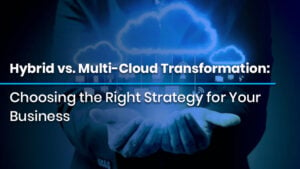Introduction
In today’s digital landscape, cloud computing offers small businesses the flexibility, scalability, and cost-efficiency needed to stay competitive. However, with the move to the cloud comes the responsibility of securing sensitive data and protecting against potential cyber threats. For small businesses that may not have dedicated IT security teams, implementing effective cloud security measures is crucial to safeguarding their operations. This blog explores essential tips and tools to help small businesses enhance their cloud security.
Fortify Your Cloud with Expert Solutions! Explore our range of cloud security services at services.ipspecialist.net. Whether it’s Cloud Transformation, AI, or IoT solutions, IPSpecialist provides the tools you need to protect your business. Begin your security journey with us today!
The Growing Importance of Cloud Security
As cloud computing becomes integral to business operations, securing cloud environments is more crucial than ever. Small businesses must stay informed about the latest trends and innovations in cloud security to protect their digital assets and ensure business continuity. By understanding their security responsibilities, implementing strong authentication practices, encrypting data, and using the right tools, small businesses can safeguard their operations against evolving cyber threats.
1. Understand Your Cloud Security Responsibilities
Before diving into specific security measures, small businesses need to understand the shared responsibility model in cloud computing. While cloud service providers (CSPs) offer robust security for their infrastructure, the responsibility for securing data, applications, and access lies with the business. Familiarize yourself with what your CSP covers and what additional measures you need to implement.
2. Implement Strong Authentication Practices
- Multi-Factor Authentication (MFA): Protect your cloud accounts by requiring multiple forms of verification before granting access. MFA significantly reduces the risk of unauthorized access by adding an extra layer of security beyond just passwords.
- Password Management: Use strong, unique passwords for each cloud service and consider employing a password manager to securely store and manage these credentials.
3. Encrypt Your Data
- Data Encryption: Ensure that sensitive data is encrypted both in transit and at rest. Encryption converts data into a secure format that can only be read with the correct decryption key. This protects your data from unauthorized access, even if it is intercepted.
- End-to-End Encryption: For enhanced security, use end-to-end encryption tools that ensure only authorized users can decrypt and access the data.
4. Regularly Back Up Your Data
- Automated Backups: Implement automated backup solutions to regularly save copies of your data. In the event of data loss or a cyber attack, having recent backups ensures you can quickly restore your operations.
- Test Backups: Regularly test your backup processes to ensure data integrity and verify that you can successfully recover information when needed.
5. Monitor and Manage Access
- Access Controls: Implement strict access controls to limit who can access your cloud resources. Use role-based access control (RBAC) to assign permissions based on user roles and responsibilities.
- Regular Audits: Conduct regular audits of user access and permissions to ensure that only authorized individuals have access to sensitive information.
6. Stay Up-to-Date with Security Patches
- Automated Updates: Enable automatic updates for your cloud software to ensure you receive the latest security patches and enhancements. Keeping your software up-to-date helps protect against known vulnerabilities.
- Patch Management: Regularly check for and apply updates to your operating systems and applications, including any third-party tools integrated with your cloud services.
7. Leverage Built-In CSP Security Features
- Provider Security Features: Take advantage of the security features offered by your cloud service provider, such as network firewalls, intrusion detection systems, and security groups. Configure these features to align with your security needs.
- Compliance Tools: Utilize compliance tools provided by your CSP to help meet regulatory requirements and ensure data protection.
8. Develop an Incident Response Plan
- Preparedness: Create a comprehensive incident response plan outlining procedures for detecting, responding to, and recovering from security incidents. Having a plan in place ensures that you can act quickly and effectively in the event of a breach.
- Regular Reviews: Regularly review and update your incident response plan to address new threats and incorporate lessons learned from past incidents.
Cloud Security Tools
Cloud security tools play a pivotal role in defending against threats and vulnerabilities inherent in cloud environments. They offer a range of functionalities, from monitoring and managing access to detecting and responding to threats. Implementing the right combination of these tools helps organizations maintain a secure and compliant cloud infrastructure.
-
Security Information and Event Management (SIEM)
- Functionality: SIEM tools aggregate and analyze security data from across your cloud infrastructure. They provide real-time insights and alerts on potential threats by correlating logs and events.
- Benefits: Enhanced threat detection, comprehensive visibility, and improved incident response capabilities. SIEM tools help organizations quickly identify and address security incidents before they escalate.
-
Cloud Security Posture Management (CSPM)
- Functionality: CSPM tools continuously assess cloud configurations to identify misconfigurations, compliance issues, and vulnerabilities. They offer automated remediation suggestions and compliance monitoring.
- Benefits: Maintains a secure cloud posture by preventing misconfigurations and ensuring adherence to industry standards and regulations. CSPM tools also help streamline compliance reporting and audits.
-
Endpoint Protection
- Functionality: Endpoint protection solutions secure devices accessing your cloud resources from threats like malware, ransomware, and unauthorized access. They include features such as antivirus, firewall, and intrusion detection.
- Benefits: Provides layered defense against cyber threats targeting endpoint devices, ensuring that all entry points into the cloud environment are protected.
-
Data Loss Prevention (DLP)
- Functionality: DLP tools monitor and control the movement of sensitive data within and outside the cloud environment. They help prevent unauthorized data transfers and ensure data is handled according to security policies.
- Benefits: Protects sensitive information from accidental or malicious data breaches, ensuring compliance with data protection regulations such as GDPR and CCPA.
-
Identity and Access Management (IAM)
- Functionality: IAM solutions manage and secure user identities and access permissions within the cloud environment. They include features like single sign-on (SSO), multi-factor authentication (MFA), and role-based access control (RBAC).
- Benefits: Ensures that only authorized users have access to specific resources, reducing the risk of insider threats and unauthorized access.
Use Cases
- E-Commerce Store: An online retailer uses Multi-Factor Authentication (MFA) to secure customer accounts and payment information, protecting against unauthorized access and fraud. Automated backups ensure that transaction data is safeguarded against loss or corruption.
- Healthcare Clinic: A small clinic encrypts patient records both in transit and at rest to comply with HIPAA regulations. Regular security training and end-to-end encryption tools help prevent unauthorized access and data breaches.
- Financial Services Firm: A financial services company uses Cloud Security Posture Management (CSPM) tools to monitor and manage its cloud environment, ensuring compliance with industry regulations and protecting sensitive financial data.
Conclusion
Securing your cloud environment is crucial for safeguarding your business’s data and ensuring continuity. By understanding your responsibilities, implementing strong authentication, and using advanced tools, you can effectively protect against threats. Regular backups, ongoing education, and leveraging built-in CSP features are essential for maintaining a robust security posture. Stay proactive and informed to fortify your cloud infrastructure. Explore our cloud security solutions at services.ipspecialist.net to enhance your protection and secure your business’s future.
FAQs
1. What is the shared responsibility model in cloud security?
The shared responsibility model outlines the division of security responsibilities between the cloud service provider (CSP) and the customer. While CSPs secure the infrastructure, customers are responsible for securing their data, applications, and access controls.
2. How can Multi-Factor Authentication (MFA) improve my cloud security?
MFA enhances cloud security by requiring multiple forms of verification (e.g., password and SMS code) before granting access. This adds an extra layer of protection against unauthorized access, reducing the risk of account compromise.
3. Why is regular data backup crucial for cloud security?
Regular data backups are essential to ensure that you can quickly restore your data in case of data loss or a cyber attack. Automated backups and periodic testing help maintain data integrity and ensure business continuity during disruptions.








